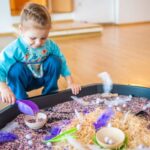From nursery walls to iconic fashion trends, baby blue has long been a beloved hue in various aspects of life. Its calming nature, timeless elegance, and versatile use make it one of the most admired colors in design, fashion, and art. But what is it about this soft shade of blue that continues to captivate people across generations? In this article, we’ll explore the origins, symbolism, and modern applications of baby blue, giving you a comprehensive guide to one of the world’s most soothing colors.
The Origins of Baby Blue
The term “baby blue” dates back to the 19th century when pastel colors began gaining popularity in fashion and interior design. The color was originally associated with infants, particularly boys, as blue was deemed a color of tranquility and gentleness. It’s no surprise that baby blue became a favorite in baby clothing and nurseries, making its way into the hearts of many new parents.
Symbolism of Baby Blue
Baby blue, with its light and delicate tone, often symbolizes serenity, peace, and innocence. It’s a color that evokes calm, making it a preferred choice in places meant for relaxation. Psychologists argue that lighter shades of blue can help reduce stress, creating an atmosphere of tranquility. So, it’s no wonder you’ll often find baby blue gracing the walls of bedrooms, spas, and meditation spaces. But this color isn’t just confined to its calming qualities; it’s also a symbol of purity and trust, making it a frequent choice for branding in industries like healthcare and technology.
Baby Blue in Fashion: A Versatile Trend
Fashion designers have long embraced baby blue for its soft, delicate feel. Whether it’s a flowing summer dress or a sleek blazer, the color works in all seasons. Baby blue is versatile and can be paired with neutrals like white or beige for a fresh, crisp look or with bold tones like navy or red for a more striking contrast.
In recent years, baby blue has been a recurring trend on fashion runways, with major designers like Chanel and Prada showcasing the color in their collections. It’s not just for women, either! Men’s fashion has also embraced baby blue, especially in formal wear like shirts, ties, and even suits. And the best part? It’s a universally flattering color, complementing a wide range of skin tones.
Quick Tips for Wearing Baby Blue:
- Pair it with neutral tones for a soft, sophisticated look.
- Mix it with metallic accents for a modern edge.
- Don’t shy away from mixing textures; baby blue velvet or satin can elevate an outfit.
Baby Blue in Interior Design
When it comes to decorating homes, baby blue is a favorite choice for creating a peaceful and airy space. It’s often used in bedrooms and bathrooms, where calmness and relaxation are essential. However, baby blue isn’t just limited to these areas. The color can also be used in living rooms or kitchens to add a fresh and lively touch.
What’s great about baby blue is that it pairs beautifully with other shades, making it ideal for color schemes. You can create a monochromatic look by combining it with deeper shades of blue, or you can opt for complementary colors like soft pinks, greys, or whites to balance the space.
How to Use Baby Blue in Your Home:
- Walls: If you’re not afraid to make a statement, paint an entire room baby blue. It can make a space feel open and serene.
- Accents: For a subtle touch, incorporate baby blue through pillows, throws, or artwork.
- Furniture: Baby blue upholstered furniture, like a sofa or an armchair, adds a splash of color without overwhelming the room.
Baby Blue in Art and Culture
Artists and designers have long understood the emotional power of colors, and baby blue is no exception. This light shade of blue has been used in paintings, sculptures, and even films to evoke feelings of nostalgia, youth, and hope. Famous artists like Pablo Picasso, during his “Blue Period,” utilized shades of blue, including baby blue, to convey melancholy and introspection. In modern times, baby blue has found its way into graphic design and digital art, where it’s often used to create a sense of calm and clarity.
The Psychology Behind Baby Blue
Why does baby blue have such a profound effect on our mood? According to color psychologists, lighter shades of blue are known to trigger feelings of tranquility and calmness. The color slows down the body’s heart rate, reducing anxiety and promoting relaxation. This makes it an excellent choice for environments where peace is crucial, such as bedrooms, hospitals, or offices where people need to focus.
Moreover, baby blue is often linked with trust and loyalty. This is why companies, particularly in the healthcare and tech sectors, incorporate baby blue into their branding. It subconsciously communicates reliability and safety, two traits every business wants to be associated with.
Baby Blue in Pop Culture
Baby blue has also made its mark in pop culture. From song titles to memorable outfits worn by celebrities, this gentle color has been in the limelight for decades. Think of iconic moments like Britney Spears’ baby blue ensemble in her “Oops!… I Did It Again” music video or the classic baby blue Cadillac in films that screams vintage cool.
Frequently Asked Questions (FAQs)
- Why is baby blue often associated with boys?
The tradition of associating baby blue with boys dates back to the early 20th century when retailers and manufacturers began marketing colors as gender-specific. Blue was seen as a color of calm and strength, traits that were culturally aligned with masculinity at the time. - Can baby blue be used in professional settings?
Absolutely! Baby blue is a versatile color that can be both calming and professional. It’s often used in corporate designs, branding, and formal attire. The key is to pair it with neutral or darker tones for a more polished look. - How can I incorporate baby blue into my wardrobe?
Baby blue is perfect for casual and formal wear. Try a baby blue blouse or shirt for a soft, approachable look. You can also accessorize with a baby blue scarf, handbag, or tie to add a subtle pop of color to any outfit. - Is baby blue a good color for a nursery?
Yes! Baby blue is a popular choice for nurseries because of its calming and soothing effects. It creates a peaceful environment, perfect for newborns. - Does baby blue work in modern home décor?
Absolutely. Baby blue can be used in modern home décor to add a fresh, clean feel. It pairs well with minimalist designs and can be complemented with metallic or wooden accents.
Conclusion: The Enduring Appeal of Baby Blue
Whether you’re painting a nursery, selecting an outfit, or designing a website, baby blue is a color that never goes out of style. Its calming effects, versatility, and cultural significance make it a timeless choice for fashion, design, and art. The next time you see this soothing hue, take a moment to appreciate the history and meaning behind it—you might just fall in love with baby blue all over again.
Authoritative Links:
- https://www.colorpsychology.org/blue/
- https://www.pantone.com/articles/color-education/color-symbolism



